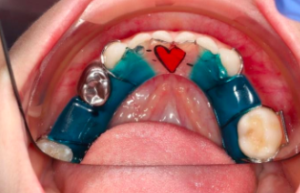Space Maintainer: What Is It? Does Your Child Need One? How to Wear and Maintain It?
This short article is an attempt to help parents understand the term “Space Maintainer”. I shall highlight briefly about what is it, why would your child need one and in case he/she gets one then how to wear and maintain it.
What is it?
Let’s get started! so the word “Space Maintainer” itself shows it means something that holds the space. Sometimes when children lose their baby teeth prematurely or too early due to trauma, diseases or other conditions then your dentist recommends your child a dental apparatus to hold space called “Space Maintainer”. It holds or preserves the space till the adult tooth grows in the space.
How does it Looks Like?
It is usually made of metal or acrylic, and can be fixed or removable. Sometimes a space maintainer is shaped like a tooth itself as it holds the space open for the growing tooth.
They come in different shapes, forms and designs. The type of space maintainer that your child might require is decided by you and your dentist after the consultation.(1) However, I can help you to get familiar with the names of different types being offered at the dental offices. Take a look below:
Unilateral: This type is used for one tooth.
Distal shoe: This one is for a permanent adult molar of your child that has not yet erupted.
Lingual: This is used when a child has lost multiple teeth.
Crown and loop: In this one crown used to cover the tooth and a loop next to it to maintain the space.
I hope now you would be slightly familiar with the names when your dentist mentions it to you next time!
Does Your Child Need One?
The normal concept popular among parents is that the adult tooth will erupt soon after the baby tooth falls out. Hence, maybe just waiting is the best solution. It is the main biggest “MISCONCEPTION”.
In case if your child loses the baby tooth too early due to any reason then the empty space is left till the adult tooth comes in place. The time period between the baby tooth loss and adult tooth eruption can be very crucial. If you do not consult your dentist in a timely manner then it can lead to be more complicated problems in future (spacing problem, gum disease etc.).(2) The erupting adult teeth ensure that the teeth are all in the right position along the jawbone giving your child a perfect smile!
The best way to know if your child is a likely candidate for a space maintainer is to consult your dentist. If left untreated, your child might suffer from more complicated conditions. Most likely, the child will wear braces to straighten the adult teeth (It is not a very pleasant experience!)
How to Wear and Maintain it?
Wearing this new thing in the mouth might be bit of a challenge for your child in the beginning. No worries your child will get comfortable with it in few days. Before you leave the dentist office, he/she will practice the steps with your child quite few times. Might ask your child to hold it with both fingers and press down on wearing it and while taking out the fingers need to be place at a certain spot. The fixed ones are fixed on the tooth but they do need special attention for cleaning and maintenance.
It is very essential that your child has a proper oral hygiene routine in order to keep the space maintainer in best shape as well as prevent decay in the teeth surrounding the maintainer.(3)
Few behavioral habits such as pressing on the space maintainer or playing with it too much can cause damage. You should discourage such habits of your child. Also, if your child is eating too many hard candies then it can be alarming too. These sticky materials can get stuck in between and are difficult to remove. So, it is always better to have a controlled intake.


Description: Two of the cases where we placed removable (left) and fixed (right) space maintainer.
Parent Tip of the Day!
It doesn’t matter which space maintainer you and your dentist has decided for your child. Good oral hygiene, brushing, flossing, avoiding sugary intake and regular appointments with your dentist are all very essential. Monitor the growth and development of your child’s dentition well.
References:
- Correction: Space maintainers in the primary and mixed dentition – A clinical guide (Br Dent J, (2018) 225, (293-298), 10.1038/sj.bdj.2018.650). British Dental Journal. 2018.
- Setia V, Pandit IK, Srivastava N, Gugnani N, Sekhon HK. Space maintainers in dentistry: Past to present. J Clin Diagnostic Res. 2013;
- Laing E, Ashley P, Naini FB, Gill DS. Space maintenance. Int J Paediatr Dent. 2009;


